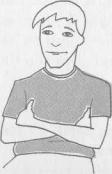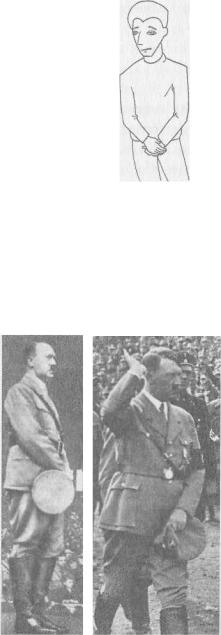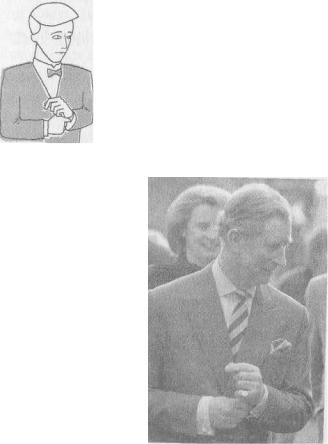
Books on Happiness / The Definitive Book Of Body Language- 2 students
.pdf
Arm Signals
Inward rotating arms allow men to throw accurately; women's outward rotating arms make for better carrying
Crossed-Arms-on-Chest
Both arms are folded together across the chest as an attempt to put a barrier between the person and someone or something they don't like. There are many arm-folding positions and we'll discuss here the most common ones you're likely to see. Crossed-Arms-on-Chest is universal and is decoded with the same defensive or negative meaning almost everywhere. It is commonly seen among strangers in public meetings, in queues or cafeteria lines, elevators or anywhere that people feel uncertain or insecure.
Crossed-Arms-on-Chest: he's not coming out and you're not coming in
93
The Definitive Book of Body Language
We attended a meeting of our local council where a debate was held on the cutting down of trees by developers. The developers sat to one side of the room and their opponents, the 'greenies', sat on the other. About half those attending sat with their arms crossed at the opening of the meeting and this increased to 90% of the 'greenies' when the developers addressed the audience, and almost 100% of the developers did it when the 'greenies' spoke. This shows how most people will take an arms-folded position when they disagree with what they're hearing. Many speakers fail to communicate their message to their audience because they haven't seen the crossed-arms position of their listeners. Experienced speakers know that this gesture means a good 'ice breaker' is needed to move their audience into a more receptive position that will change their attitude from negative to positive.
When you see someone take the arms-crossed position, it's reasonable to assume that you may have said something with which they disagree. It may be pointless continuing your line of argument even though the person could be verbally agreeing with you. The fact is that body language is more honest than words.
As long as someone holds an arms-folded position, a negative attitude will persist.
Your objective should be to try to work out why they crossed their arms and to try to move the person into a more receptive position. The attitude causes the gesture to occur and maintaining the gesture forces the attitude to remain.
Solution
A simple but effective way of breaking the arms-folded position is to give the listener something to hold or give them something to do. Giving them a pen, book, brochure, sample
94
Arm Signals
written test forces them to unfold their arms and lean forward. This moves them into a more open position and, therefore, a more open attitude. Asking someone to lean forward to look at a visual presentation can also be an effective means of opening the arms-folded position. You could also lean forward with your palms up and say, 'I can see you have a question...what would you like to know?' or, 'What's your opinion?' You then sit or lean back to indicate that it's their turn to speak. By using your palms you non-verbally tell them that you would like them to be open and honest because that's what you're being.
Why am I holding all these pens, pencils and brochures?' asked the customer, who began to look like a decorated Xmas tree. I'll come to that later,' said the negotiator.
Salespeople and negotiators are often taught that it's usually safer not to proceed with the presentation of a product or idea until the prospect's reason for folding his arms is uncovered. More often than not, buyers have hidden objections that most salespeople never discover because they missed seeing the buyer's arms-folded cluster, signalling that he was feeling negative about something.
Reinforced Arm-Crossing
If a person has clenched fists as well as a full arm-cross, this cluster, called Fists-Clenched-Arm-Crossed, shows hostility as well as defensiveness. If it's combined with a tight-lipped smile or clenched teeth and red face, a verbal or even physical attack couldhappen. A conciliatory approach is needed to discover
what is causing it if the reason is not already apparent. This person has an aggressive, attacking attitude.
95

The Definitive Book of Body Language
Fists-Clenched-Arms- Crossed shows a hostile attitude exists
Arm-Gripping
The Double-Arm-Grip is characterised by the person's hands tightly gripping their upper arms to reinforce themselves and avoid exposure of the front of the body. Sometimes the arms can be gripped so tight that the fingers and knuckles can turn white as blood circulation is cut off. It's a person's way of comforting himself with a form of self-hugging. Arm-gripping is commonly seen in doctors' and dentists' waiting rooms or with first-time air travellers who are waiting for lift-off. It shows a negative, restrained attitude.
The Double-Arm-Grip: feeling insecure and not buying what you're selling
In a courtroom, the claimant may be seen using a Fists- Clenched-Arm-Crossed pose while the defendant may have taken the Double-Arm-Grip position.
96

Arm Signals
The Boss vs The Staff
Status can influence arm-folding gestures. A superior type can make his superiority felt by not folding his arms, saying, in effect, 'I'm not afraid, so I'll keep my body open and vulnerable.' Let's say, for example, that at a company social function, the general manager is introduced to several new employees. playinggreeted them with a Palm-Down handshake, he stands back from them - a yard away (1 metre) - with his hands by his side or behind his back in the Prince Philip Palm-in-Palm position (superiority), or with one or both hands in his pocket (non-involvement). He rarely folds his arms across his chest so as not to show the slightest hint of nervousness.
Conversely, after shaking hands with the boss, the new employees may take full or partial arm-crossing positions because of their apprehension about being in the presence of the company's top person. Both the general manager and the new employees feel comfortable with their respective gesture clusters as each is signalling his status, relative to the other. But what happens when the general manager meets a young, up- and-coming male who is also a superior type and who may even signal that he is as important as the general manager? The likely outcome is that, after the two give each other a dominant handshake, the younger executive may take an armfold gesture with both thumbs pointing upwards.
Thumbs-Up: defensive, but he still thinks he's pretty cool
97
The Definitive Book of Body Language
This gesture has the arms-crossed plus both thumbs up showing that he's feeling 'cool' and in control. As he talks, he gestures with his thumbs to emphasise points he is making, As we've already discussed, the thumbs-up gesture is a way of showing others we have a self-confident attitude and the folded arms still gives a feeling of protection.
Someone who is feeling defensive but also submissive at the same time will sit in a symmetrical position, which means one side of their body is a perfect mirror of the other. They display tense muscle tone and look as if they expect to be attacked whereas a person who is feeling defensive and dominant will take an asymmetrical pose, that is, one side of the body doesn't mirror the other.
Getting theThumbs-Up
When you're presenting your case to someone and the Thumbs-Up-Arms-Crossed appears towards the end of your presentation and is clustered with other positive gestures, it signals you can move comfortably into asking the person for a commitment. On the other hand, if at the close of the presentation the other person takes the Fists-Clenched-Arms- Crossed position and has a poker face, you can be inviting trouble by attempting to get a 'yes'. It would be better to ask questions to try to uncover the person's objections. When someone says 'no' to a proposal, it can become difficult to change their mind without looking as if you're aggressive. The ability to read body language allows you to 'see' a negative decision before it is verbalised and gives you time to take an alternative course of action.
When you can see a 'no' before it's said, you can try a different approach.
98

Arm Signals
People carrying weapons or wearing armour seldom use armgestures because their weapon or armour provides sufficient body protection. Police officers who wear guns, for example, rarely cross their arms unless they are standing guard and they normally use the fist-clenched position to communicate clearly that nobody is permitted to pass where they are standing.
HuggingYourself
When we were children our parents or carers embraced or hugged us when we faced distressing or tense circumstances. As adults, we often attempt to recreate those same comforting feelings when we find ourselves in stressful situations. Rather than take a full arm-cross gesture, which can tell everyone we are fearful, women often substitute a subtler version - a Partial- Arm-Cross, where one arm swings across the body to hold or touch the other arm to form the barrier and it looks as if she is hugging herself. Partial arm barriers are often seen in meetings where a person may be a stranger to the group or is lacking in self-confidence. Any woman taking this position in a tense situation will usually claim she is just being 'comfortable'.
Holding herself like her mother held her when she was a child
Men use apartial arm barrierknown as Holding-Hands-With- Yourself : it's commonly used by men who stand in front of a
99

The Definitive Book of Body Language
crowd to receive an award or give a speech. Also known as the Broken Zipper Position it makes a man feel secure because he can protect his 'crown jewels' and can avoid the consequences of receiving a nasty frontal blow.
The Broken
Zipper Position
It's the same position men take in a line at a soup kitchen or to receive social security benefits and reveals their dejected, vulnerable feelings. It recreates the feeling of having someone else hold your hand. Adolf Hitler used it regularly in public to mask the sexual inadequacy he felt because of having only one testicle.
It's possible that evolution shortened men's arms to allow them to take this protective position because when our closest primate cousins, the chimpanzees, assume the same position their hands cross at their knees.
Humans make a point of hiding the areas they think are their weakest or most vulnerable
100

Arm Signals
How the Rich and Famous Reveal their Insecurity
People who are continually exposed to others, such as royalty, politicians, television personalities and movie stars, usually don't want their audiences to detect that they are nervous or unsure of themselves. They prefer to project a cool, calm, controlled attitude when on display, but their anxiety or apprehension leaks out in disguised forms of arm-crossing. As in all arm-cross gestures, one arm swings across in front of the body towards the other arm but instead of the arms crossing, one hand touches or holds on to a handbag, bracelet, watch,' shirt cuff or object on or near their other arm. Once again the barrier is formed and the secure feeling is achieved.
Famous people are just as nervous in public as the rest of us
Men wearing cufflinks are often seen adjusting them as they cross a room or dance floor where they are in full view of others. The
Cuff-Link-Adjust is the trademark of Prince Charles, who uses it to give himself a feeling of security any time he walks across an open space in full view of everyone.
Prince Charles' Cuff-Link-Adjust revealing his insecurities
101

The Definitive Book of Body Language
You would think that after more than half a century of being scrutinised in public and being confronted by large crowds royals, such as Prince Charles, would be resistant to nervous feelings but his small arm-crossing behaviours reveal that he feels just as insecure as you or I would feel in the same circumstances.
An anxious or self-conscious man will also be seen adjusting the band on his watch, checking the contents of his wallet clasping or rubbing his hands together, playing with a button on his cuff or using any gesture that lets his arms cross in front of his body. A favourite of insecure businessmen is walking into a business meeting holding a briefcase or folder in front of the body. To the trained observer, these gestures are a giveaway because they achieve no real purpose except as an attempt to disguise nervousness. A good place to observe these gestures is anywhere that people walk past a group of onlookers, such as a man who crosses the dance floor to ask a woman to dance or someone who crosses a stage to receive an award.
Women's use of disguised arm barriers is less noticeable than men's because women can grasp onto things like handbags or purses if they become self-conscious or unsure of themselves. Royals like Princess Anne regularly clutch a bunch of flowers when walking in public and the Flowers/HandbagClutch is Queen Elizabeth's favourite. It's unlikely that she would be carrying lipstick, make-up, credit cards and theatre tickets in her handbag. Instead, she uses it as a type of security blanket when necessary and as a means of sending messages; royal watchers have recorded 12 signals she sends to her minders about when she wants to go, stop, leave or be rescued from someone who is boring her.
Handbag used to form a barrier
02
